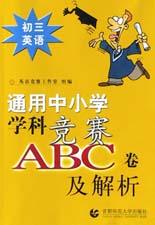

具體描述
著者簡介
圖書目錄
CONTENTS
I. Introduction
1. What is lexicology?
2. The five sub-branches of lexicology
3. The relations of lexicology to other branchesof linguistics
3.1 Its relation to general linguistics
3.2 Its relation to grammar
3.3 Its relation to phonetics
3.4 Its relation to stylistics
4. The significance of learning lexicology
1.The English Vocabulary
1.A glimpse at the English vocabulary
1.1 Extremely rich vocabulary
1.2 Native words being the foundation of English
1.3 The rapid growth of the present-day English vocabulary
1.4 Three periods of the history of the English language
2. Classification of English words accordmg to different criteria
2.1 According to origin
2.2 According to level of usage
2.3 According to notion
3 Sources of the English vocabulary
3.1 Native element
3.2 Foreign element
Word-structure
1 Morphemes
1.1 What isa morpheme?
1.2 Morphemes and phonemes
1.3 Morphemes and syllables
2 Classification of morphemes
2.1 Free morphemes and bound morphemes
2.2 Roots and affixes
2.3 Relationship between the two classifications
3. Classification of words on morohemic level
4. Root, stem , base
5. Hybrids
English Word-formation
1. Ways of word-formation
2. Compounding
2.1 What is compounding?
2.2 Classification of compounds
2.3 The stylistic value of compounds
2.4 The differences between compounds and
free phrases
3. Derivation
3.1 What is derivation?
3.2 Classification of derivation
4 Conversion
4.1 What is conversion?
4.2 Types of conversion
4.3 The stylistic value of converted words
5 Clipping
5.1 What is clipping?
5.2 Types of clippings
5.3 Characteristics of clippings
6 Initialisms
6.1 What is initialism?
6.2 Types of initialisms
7 Acronyms
7.1 What are acronyms?
7.2 Some characteristics of acronyms
8 Blending
8.1 What is blending?
8.2 Classification of blends
9 Back-formation
9.1 What is back-formation?
9.2 Types of back-formation
10 Reduplication
10.1 What is reduplication?
10.2 Types of reduplication
11. Words from proper names
12. Shift of stress
V. Semantics
1. Semantics
2. Types of word meaning
2.1 Grammatical meaning
2.2 Lexical meaning
3. Polysemy
3.1 What is polysemy?
3.2 Two processes leading to polysemy
3.3 Polysemy and context
4. Homonyms
4.1 What are homonyms?
4.2 Classification of homonyms
4.3 The stylistic value of polysemy and
homonymy
5. Synonymy
5.1 What is synonymy?
5.2 Synonymous patterns
5.3 Types of synonyms
6. Antonymy
6.1 What is antonymy?
6.2 Types of antonyms
6.3 Some relevant points about antonyms
7. Hyponymy
8. Semantic field
VI Change of Meaning
1 Causes of changes in word meaning
1.1 The extra-linguistic causes
1.2 Linguistic cause
2 Four tendencies in semantic change
2.1 Restriction of meaning(specialization)
2.2 Extension of meaning(generalization)
2.3 Degeneration of meaning(pejoration)
2.4 Elevation of meaning(amelioration)
3 Figures of speech
3.1 Figures based on resemblances
3.2 Figures based on contrast
3.3 Figures based on other relations
V Idiom
1 Definition of idiom
1.1 General definition of idiom
1.2 Specific definition of idiom
2 Characteristic features of English idioms
2.1 Semantic unity
2.2 Structural stability
3 Classification of English idioms
3.1 Classification according to the types ofmotivation of idioms
3.2 Classification according to the sources ofidioms
3.3 Classification according to the lexical or phonetic make-up
3.4 Classification according to structural criteria and grammatical functions
4. The semantic relationship between the com-bination as a whole and its components
5 Rhetorical and stylistic analysis
5.1 Emphatic repetition of the same word or the same meaning conveyed by two different
words
5.2 Contrast of two alternatives
5.3 Vivid comparison
6 The practical application of idioms
6.1 The syntactic function
6.2 Collocation
6.3 Variability of usage
American English
1 A brief historical background of American
English
2 Characteristics of American English
2.1 Creativity
2.2 Conservatism
2.3 Uniformity
2.4 Popularity of slang
2.5 Simplicity
3 Differences between British and American
English
3.1 Differences in pronunciation and intonation
3.2 Ditterences in grammar
3.3 Differences in vocabulary
3.4 Differences in spelling and punctuation
IX English Lexicography
1 Lexicography and its relationship with lexicology
1.1 What is lexicography?
1.2 The relationship between lexicography and lexicology
2. Types of dictionaries
2.1 Linguistic and non-linguistic dictionaries
2.2 General and special dictionaries
2.3 Monolingual and bilingual dictionaries
2.4 Diachronic and synchronic dictionaries
3 How to choose and use a dictionary?
3.1 How to choose a dictionary?
3.2 How to use a dictionary?
3.3 Recommendation of some up-to-date
dictionaries
Key to Exercises
Blbliography
Appendixes
1 Classification of the world's Languages
1 The Indo--European Language Family
1 A Table of Graded Words
IV A Glossary in English and Chinese
· · · · · · (收起)
I. Introduction
1. What is lexicology?
2. The five sub-branches of lexicology
3. The relations of lexicology to other branchesof linguistics
3.1 Its relation to general linguistics
3.2 Its relation to grammar
3.3 Its relation to phonetics
3.4 Its relation to stylistics
4. The significance of learning lexicology
1.The English Vocabulary
1.A glimpse at the English vocabulary
1.1 Extremely rich vocabulary
1.2 Native words being the foundation of English
1.3 The rapid growth of the present-day English vocabulary
1.4 Three periods of the history of the English language
2. Classification of English words accordmg to different criteria
2.1 According to origin
2.2 According to level of usage
2.3 According to notion
3 Sources of the English vocabulary
3.1 Native element
3.2 Foreign element
Word-structure
1 Morphemes
1.1 What isa morpheme?
1.2 Morphemes and phonemes
1.3 Morphemes and syllables
2 Classification of morphemes
2.1 Free morphemes and bound morphemes
2.2 Roots and affixes
2.3 Relationship between the two classifications
3. Classification of words on morohemic level
4. Root, stem , base
5. Hybrids
English Word-formation
1. Ways of word-formation
2. Compounding
2.1 What is compounding?
2.2 Classification of compounds
2.3 The stylistic value of compounds
2.4 The differences between compounds and
free phrases
3. Derivation
3.1 What is derivation?
3.2 Classification of derivation
4 Conversion
4.1 What is conversion?
4.2 Types of conversion
4.3 The stylistic value of converted words
5 Clipping
5.1 What is clipping?
5.2 Types of clippings
5.3 Characteristics of clippings
6 Initialisms
6.1 What is initialism?
6.2 Types of initialisms
7 Acronyms
7.1 What are acronyms?
7.2 Some characteristics of acronyms
8 Blending
8.1 What is blending?
8.2 Classification of blends
9 Back-formation
9.1 What is back-formation?
9.2 Types of back-formation
10 Reduplication
10.1 What is reduplication?
10.2 Types of reduplication
11. Words from proper names
12. Shift of stress
V. Semantics
1. Semantics
2. Types of word meaning
2.1 Grammatical meaning
2.2 Lexical meaning
3. Polysemy
3.1 What is polysemy?
3.2 Two processes leading to polysemy
3.3 Polysemy and context
4. Homonyms
4.1 What are homonyms?
4.2 Classification of homonyms
4.3 The stylistic value of polysemy and
homonymy
5. Synonymy
5.1 What is synonymy?
5.2 Synonymous patterns
5.3 Types of synonyms
6. Antonymy
6.1 What is antonymy?
6.2 Types of antonyms
6.3 Some relevant points about antonyms
7. Hyponymy
8. Semantic field
VI Change of Meaning
1 Causes of changes in word meaning
1.1 The extra-linguistic causes
1.2 Linguistic cause
2 Four tendencies in semantic change
2.1 Restriction of meaning(specialization)
2.2 Extension of meaning(generalization)
2.3 Degeneration of meaning(pejoration)
2.4 Elevation of meaning(amelioration)
3 Figures of speech
3.1 Figures based on resemblances
3.2 Figures based on contrast
3.3 Figures based on other relations
V Idiom
1 Definition of idiom
1.1 General definition of idiom
1.2 Specific definition of idiom
2 Characteristic features of English idioms
2.1 Semantic unity
2.2 Structural stability
3 Classification of English idioms
3.1 Classification according to the types ofmotivation of idioms
3.2 Classification according to the sources ofidioms
3.3 Classification according to the lexical or phonetic make-up
3.4 Classification according to structural criteria and grammatical functions
4. The semantic relationship between the com-bination as a whole and its components
5 Rhetorical and stylistic analysis
5.1 Emphatic repetition of the same word or the same meaning conveyed by two different
words
5.2 Contrast of two alternatives
5.3 Vivid comparison
6 The practical application of idioms
6.1 The syntactic function
6.2 Collocation
6.3 Variability of usage
American English
1 A brief historical background of American
English
2 Characteristics of American English
2.1 Creativity
2.2 Conservatism
2.3 Uniformity
2.4 Popularity of slang
2.5 Simplicity
3 Differences between British and American
English
3.1 Differences in pronunciation and intonation
3.2 Ditterences in grammar
3.3 Differences in vocabulary
3.4 Differences in spelling and punctuation
IX English Lexicography
1 Lexicography and its relationship with lexicology
1.1 What is lexicography?
1.2 The relationship between lexicography and lexicology
2. Types of dictionaries
2.1 Linguistic and non-linguistic dictionaries
2.2 General and special dictionaries
2.3 Monolingual and bilingual dictionaries
2.4 Diachronic and synchronic dictionaries
3 How to choose and use a dictionary?
3.1 How to choose a dictionary?
3.2 How to use a dictionary?
3.3 Recommendation of some up-to-date
dictionaries
Key to Exercises
Blbliography
Appendixes
1 Classification of the world's Languages
1 The Indo--European Language Family
1 A Table of Graded Words
IV A Glossary in English and Chinese
· · · · · · (收起)
讀後感
評分
評分
評分
評分
評分
用戶評價
评分
评分
评分
评分
评分
相關圖書
本站所有內容均為互聯網搜索引擎提供的公開搜索信息,本站不存儲任何數據與內容,任何內容與數據均與本站無關,如有需要請聯繫相關搜索引擎包括但不限於百度,google,bing,sogou 等
© 2025 book.quotespace.org All Rights Reserved. 小美書屋 版权所有




















